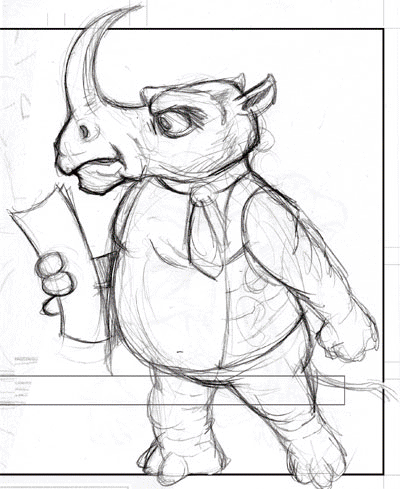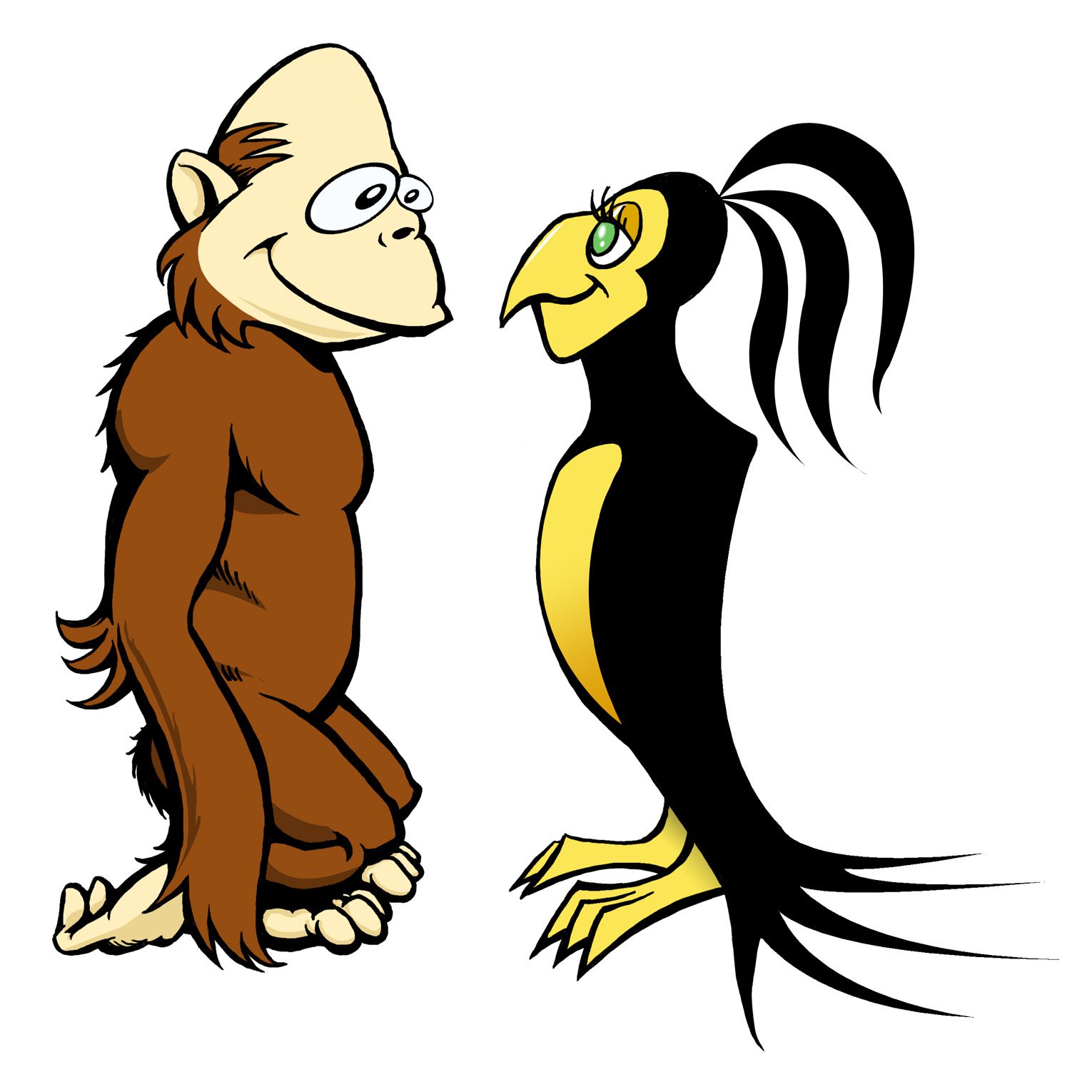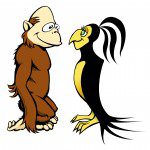Ink from a bottle or digital ink? The ENDLESS STRUGGLE continues, but this time the turmoil is WITHIN as I cast aside the new digital techniques and once again embrace the tools of old!
This is a followup of sorts to earlier articles about traditional art supplies versus art created on the computer. Raine! Raine! Don’t Go Away! or Pigments Versus Pixels was about illustrator Raine Szramski’s run-in with a misguided fellow who suggested that she abandon her paints and brushes in favor of digital illustration. Raining on Raine’s Parade was the other article that suggested that Raine’s critic wasn’t completely off-base.
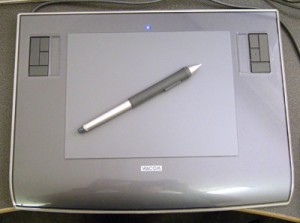 Truth be told, I’m not real crazy about inking digitally. I work on a medium sized digitizing tablet known as a Wacom Intuos, and it’s taken quite a bit of time getting used to drawing with it. It’s a marvelous device, but it doesn’t feel like real drawing. It feels like plastic contacting plastic and not like the natural resistance of a pen or a pencil going across paper. Sure, there are adjustments that can be made to the digital brushes and there are low-tech hacks that can be done like taping a piece of paper to the Wacom’s surface or using the felt tips on the stylus, but it’s still not natural. You are drawing down on a flat surface and looking up at a monitor. It’s weird.
Truth be told, I’m not real crazy about inking digitally. I work on a medium sized digitizing tablet known as a Wacom Intuos, and it’s taken quite a bit of time getting used to drawing with it. It’s a marvelous device, but it doesn’t feel like real drawing. It feels like plastic contacting plastic and not like the natural resistance of a pen or a pencil going across paper. Sure, there are adjustments that can be made to the digital brushes and there are low-tech hacks that can be done like taping a piece of paper to the Wacom’s surface or using the felt tips on the stylus, but it’s still not natural. You are drawing down on a flat surface and looking up at a monitor. It’s weird.
I know somebody will chime in and suggest that the Wacom Cintiq is the way to go. For those of you not familiar, a Cintiq is sort of a flat panel monitor that you can draw on with the stylus. Very cool, and it should be at $2,000. I would gladly accept one as a gift or a long term loaner to thoroughly test it out. Make me eat my words! Get me a Cintiq!
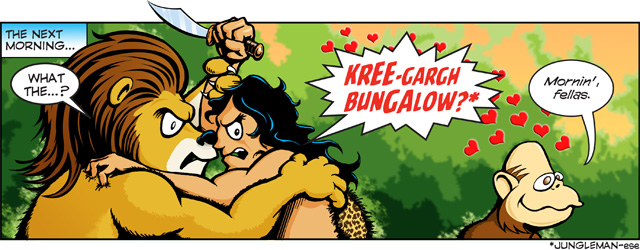 I went to digital inking in about the fifth or sixth installment of the first chapter of Monkey & Bird. It’s the page where a love-struck Mickey walks past a lion battling it out with Jungle Man. After that, I inked the rest of that chapter digitally in Photoshop using the Wacom tablet. I still do the sketching with real world pencils, pens or whatever I have lying around in sketchbooks or scratch pads. What I usually do is scan the sketches in and place them in a page layout. I then create a layer over the scanned sketches; set the layer to Multiply, and start inking the comic.
I went to digital inking in about the fifth or sixth installment of the first chapter of Monkey & Bird. It’s the page where a love-struck Mickey walks past a lion battling it out with Jungle Man. After that, I inked the rest of that chapter digitally in Photoshop using the Wacom tablet. I still do the sketching with real world pencils, pens or whatever I have lying around in sketchbooks or scratch pads. What I usually do is scan the sketches in and place them in a page layout. I then create a layer over the scanned sketches; set the layer to Multiply, and start inking the comic.
Before going completely digital, I was experimenting with techniques of transferring my sketchbook sketches to the layout page for inking. I didn’t want to trace the sketches onto bristol using a lightbox. That’s the way I’ve done it for years, and it always seemed to suck the energy right out of the original drawings. So I scanned the drawings, turned them into a light, non-repro (hopefully) blue, and printed them out on a nice sheet of hot-press bristol which I had cut down to a size that would fit through an Epson desktop printer. I’d tighten up what needed it in pencil and ink over that. It worked for the most part. The problem was that 8.5″ by 11″ is claustrophobically small for drawing a comic page, and the non-repro blue was never really a non-repro blue. The scanner would pick up stray lines and other crap I didn’t want it to pick up. There would be a lot of clean up on the digital side. This is why I figured on going digital. If I was going to do as much clean up and redrawing of the scanned page digitally, I may as well do the whole thing digitally!
 So I was going along fine, happily inking my comic with a Wacom until the alcoholic baboon came along. I was playing around with a story within a story and I wanted the styles to be different. I kept on watching old films for film noir lighting ideas and I got crazy sketching the baboon. He had a lot more detail than the regular cast of characters. I really went nuts with the mane. When it came time to ink the story, I did ink this image digitally, but I wasn’t happy with the results. One of the problems with inking digitally is that you can zoom into the drawing like a microscope and kill a lot of time either trying to lay down the perfect ink line or adding details that nobody will see. I scrapped the digital inks; cut down a nice piece of Strathmore 500 series bristol and got out my tools.
So I was going along fine, happily inking my comic with a Wacom until the alcoholic baboon came along. I was playing around with a story within a story and I wanted the styles to be different. I kept on watching old films for film noir lighting ideas and I got crazy sketching the baboon. He had a lot more detail than the regular cast of characters. I really went nuts with the mane. When it came time to ink the story, I did ink this image digitally, but I wasn’t happy with the results. One of the problems with inking digitally is that you can zoom into the drawing like a microscope and kill a lot of time either trying to lay down the perfect ink line or adding details that nobody will see. I scrapped the digital inks; cut down a nice piece of Strathmore 500 series bristol and got out my tools.
The old tools aren’t that old. I used to favor technical pens and nylon brushes, but now I go with felt-tip pens and markers. The tech pens were fine for the hatchy/scratchy illustration style I used to do, but I never really use them for cartoon inking. They’re too fine and mechanical. Nylon brushes kind of wore out their welcome with me. The kind I liked got harder to find, and the ones I liked would usually split into an annoying V after one inking job. I’d clean them with saddle soap and take good care of them, but they would crap out on me. It always turned into a mad sorting ritual when I was starting a drawing. I was going through a pile of brushes looking for a good one. Sadly, most times the good one was the new one I had to buy at the art supply store.
The sketch was already scanned in so I turned it a light blue in Photoshop and printed it out on to the bristol. I tightened the drawing in pencil, and then inked in in with Pigma and Faber-Castell pens. The Pigma pens hold their tips really well. The ink is water-proof and they handle better than a technical pen. Both Pigma and Faber-Castell brush pens are remarkable in that they are felt-tips that act just like a brush. I stopped using brushes after I found brush pens, but they can be hard to find. I’m still working off a stash of pens I bought a while back. If you see them and like them, clear out the store’s inventory!
Not pictured is the fabulous Pentel Pocket Brush which is like a nylon brush crossed with a fountain pen. It feeds off of cartridges of ink in the barrel of the handle, and it really is a pleasure using.
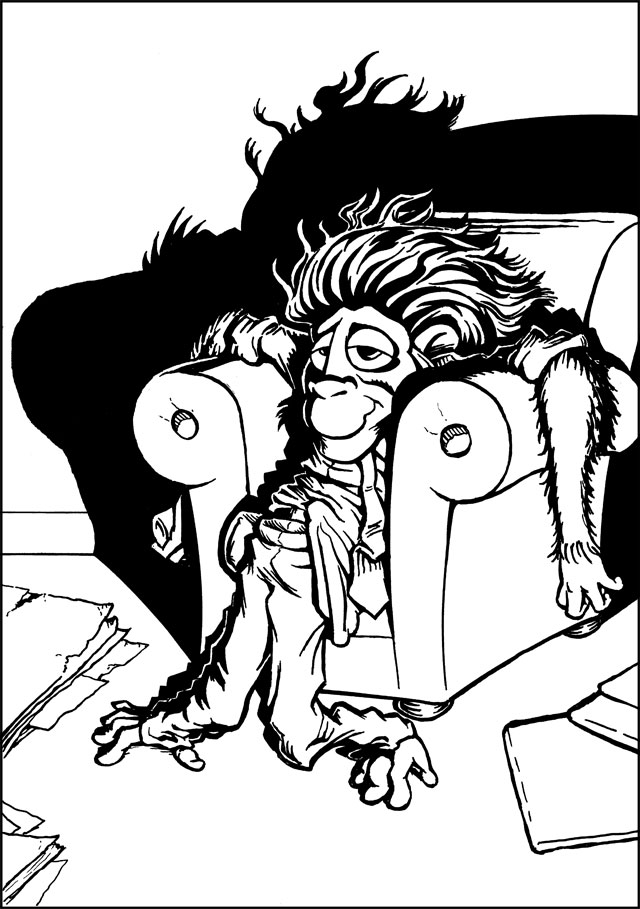 So I inked it in by hand and it was a lot of fun sort of like riding an old bike or chatting with a long lost friend. I felt satisfied with the end result which isn’t always the case with the Wacom. There’s times where I feel I settle. I still did some clean up and filled in large areas of black digitally, but the hard and satisfying parts were done by hand.
So I inked it in by hand and it was a lot of fun sort of like riding an old bike or chatting with a long lost friend. I felt satisfied with the end result which isn’t always the case with the Wacom. There’s times where I feel I settle. I still did some clean up and filled in large areas of black digitally, but the hard and satisfying parts were done by hand.
…and then I changed my mind. Once I got out of The Lost Baboon Weekend story within the story. I went back to digital inking. The regular characters are smoother particularly Bird, and I wanted cleaner lines. Wacom over scanned sketches again.
Then there was the strip with the poetic rhino so I changed my mind back again! This time, I was using a new acquisition. I was looking at large format printers thinking how nice it would be if I did my light blue sketch print-out on a full tabloid sized comic page. It would be like a professional comic size and wouldn’t be as cramped as letter-size. I was thinking of getting an Epson Workforce printer that prints tabloid size. They go for about $200, and I saw one on a great sale, but I still couldn’t justify the cost. I ended up getting a second-hand Epson R-1800 as an especially generous Christmas gift. It prints an incredible 13″x19″ or huge banners if you have the paper and are so inclined. The poetry party in Inky’s bar was going to be the test of the new printer. I printed the scanned sketch on a piece of bristol and inked away!
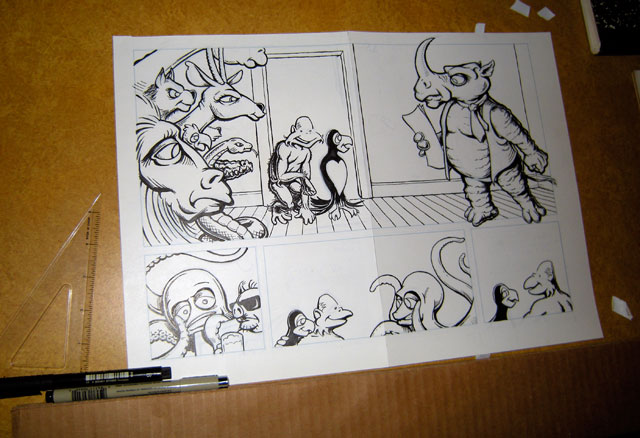 This was a lot of fun to do, but the jury is still out for me on how I want to proceed with my various inking techniques in the future. I’m happy with the way this turned out, but I still had to cut it in half to fit it on my scanner. There is a reasonably priced large format scanner out there that can handle tabloid sized art, but money is tight as it is for everybody so I’ll make do with what I have
This was a lot of fun to do, but the jury is still out for me on how I want to proceed with my various inking techniques in the future. I’m happy with the way this turned out, but I still had to cut it in half to fit it on my scanner. There is a reasonably priced large format scanner out there that can handle tabloid sized art, but money is tight as it is for everybody so I’ll make do with what I have
I know the title of the column is Pixels Versus Pigments, but outside of black, we don’t really use any pigments. The color has always been done digitally and always will be. The color is a collaboration between Tina and myself. She figures out the palettes and patterns and I play around with effects and happy accidents. Doing the colors the way we do makes it easier to adjust, play around and experiment. Scanning in painted pieces adds another variable that would have to be adjusted in Photoshop. That color that looked so great on water color paper may look atrocious scanned into the computer. Besides, if you saw any of my attempts at painting, you would beg me to go back to the computer!

